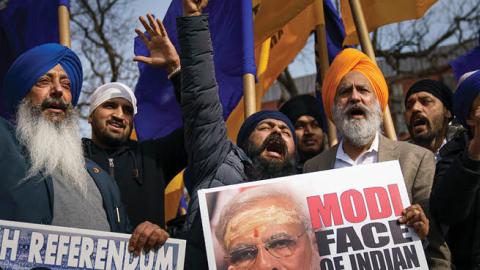Key Points
- Hudson Institute’s South and Central Asia Program assembled a group of South Asia experts to evaluate the fifty-five interlinked Kashmiri and Khalistani groups currently operating within the United States and the possibility that these groups receive funding, support, and military training from Pakistan, have ties to militant and terrorist groups in India, and could detrimentally impact US foreign policy in South Asia.
- The activities of Khalistani groups located in North America should be investigated, within the limits prescribed by law, to prevent a reoccurrence of the violence orchestrated by the Khalistan movement in the 1980s. During that period, along with numerous attacks on civilians, the Khalistan movement was linked to the 1985 bombing of Air India Flight 182 from Montreal to London that left 329 dead and the failed bombing of an Air India jet in Tokyo on the same day.
- The US government has shown reluctance to act on intelligence from India concerning Pakistan-supported Khalistan militancy, largely due to Pakistan’s role as the artery providing logistical support to the US military mission in Afghanistan following 9/11. Compounding the issue, China has blocked the designation of Pakistan-based terrorists under the United States’ terrorist-designation process within the United Nations Security Council.
Introduction
For many years, a few members of the Sikh diaspora located in North America have supported the creation of a separate state for Sikhs—to be called Khalistan—in the Indian state of Punjab bordering Pakistan and the volatile Jammu and Kashmir region. While demands for a separate Sikh state were voiced prior to the dissolution of British India in 1947, Sikh militants did not begin employing violence to advance their demands until the late 1970s and continued to do so through the early 1990s.
In 1984, Prime Minister Indira Gandhi dispatched the Indian army to oust militants and their leaders from the holiest of Sikh shrines, the expansive Golden Temple, which they had occupied and then fortified with weapons brought from Pakistan. Gandhi’s action served to galvanize Sikhs living abroad, as did the anti-Sikh pogroms that occurred following Sikh militants’ 1984 assassination of Prime Minister Gandhi in retaliation for the Golden Temple military operation.
During the course of the fifteen-year campaign of violence that lasted until the early 1990s, some 25,000 were murdered, mostly Sikhs. Despite the long period of dormancy that then followed, Khalistani militancy has increased in recent years, and so curtailment of diaspora-based efforts to re-invigorate it may prevent a return to the violence of the 1980s.
Such diaspora-based efforts are worrisome because Pakistan’s intelligence agency, the Inter-Services Intelligence Directorate (ISI), may be assisting pro-Khalistan groups financially and organizationally. Admittedly, Pakistan and India frequently accuse one another of fomenting separatist insurgencies within each other’s territory. For instance, following India’s documentation of Pakistan’s widely acknowledged support of terrorism and violence in India, a Pakistani dossier circulated among the permanent members of the UN Security Council accused India of supporting militant resistance to Pakistani rule in Balochistan, which borders Iran and Afghanistan. However, unlike Pakistan’s tit-for-tat accusations of India, its organized support of terrorist activities to pursue its claims on Jammu and Kashmir have attracted international attention since at least 1992.
For years, the United States and most of the international community have condemned Pakistan’s tolerance of and support for terrorism. Moreover, the US Department of State’s Country Report on Terrorism 2019: Pakistan states, “Pakistan continued to serve as a safe haven for certain regionally focused terrorist groups. It allowed groups targeting Afghanistan, including the Afghan Taliban and affiliated HQN [Haqqani Network], as well as groups targeting India, including LeT [Lashkar-e-Tayyaba] and its affiliated front organizations, and JeM [Jaish-e-Mohammed], to operate from its territory.”
In addition, the report continues, “Islamabad has yet to take decisive actions against Indian- and Afghanistan-focused militants who would undermine their operational capability.” The Indian government and several independent scholars believe that militancy in Jammu and Kashmir, as well as the Khalistan movement, are parts of Pakistan’s plan for “bleeding India with a thousand cuts.”
According to data collected by Gallup, American public opinion regarding Pakistan has, in general, been strongly negative since 2000, with solid majorities expressing unfavorable views of it. After US Navy SEALs found and killed al-Qaeda leader Osama bin Laden in Abbottabad in May 2011, a short distance from Pakistan’s premier military academy, a plurality of Americans believed Pakistan undermined rather than aided American efforts to locate him.
Despite the strength of public opposition to Pakistan, the United States government subsequently failed to develop policy measures to coerce that country into abandoning jihad as a foreign policy tool and, curiously, viewed Pakistan’s support of terrorism as the problem of other countries in the region rather than of the United States. This stance, however, changed in the aftermath of the November 2008 Lashkar-e-Tayyaba attack on Indian port and megacity Mumbai, in which ten Lashkar-e-Tayyaba gunmen murdered at least 174 people and injured several hundred more.
While the vast majority of the attack’s victims were Indian, it also claimed the lives of twenty-six foreign nationals, including several Americans. In the weeks and months following the attack, the extent of the support provided the attack team by Pakistan’s ISI became increasingly obvious, and US policymakers increased their level of attention on Pakistan-sponsored terrorism, including holding somewhat regular Congressional hearings on these activities.
Unfortunately, the United States government has shown no interest in violence committed by Khalistan activists, even though the Khalistan campaign’s most ardent supporters are located in western countries such as the United Kingdom, Canada, and the United States. Despite urgent Indian requests to these countries to curb Khalistan separatist groups within their borders, their governments have remained unresponsive to India’s appeals. Making these demurrals all the more puzzling is the increasing involvement over the last decade of Khalistani groups with Pakistan’s so-called Kashmiri groups, who have also become the focus of American intelligence and policy communities.
Cooperation between Khalistani and Kashmiri groups has become increasingly apparent in North America, the United Kingdom, and Europe, with Kashmiri and Khalistani activists often operating in tandem. For example, in August 2020, Khalistani and Kashmiri activists staged a demonstration in New York against India, and, in September 2019, activists appropriated imagery and slogans from the Black Lives Matter movement, whose aim is to redress systemic and structural white supremacy in the United States. Joint protests of Khalistani and Kashmiri separatists have occurred in Washington DC, Houston, Ottawa, London, Brussels, Geneva, and other European capitals.
Anticipation constitutes a crucial part of national security planning, and, therefore, investigating, within the limits prescribed by law, the activities of Khalistani groups located in North America is important to preventing a reoccurrence of the violence orchestrated by the Khalistan movement in the 1980s. During that period, along with numerous attacks on civilians, the Khalistan movement was linked to the 1985 bombing of Air India Flight 182 from Toronto to Mumbai that left 329 dead and the failed bombing of an Air India jet in Tokyo on the same day.
Importantly, the recent increase in Khalistan-related anti-India activism within the US is occurring as the United States and India are collaborating to confront the rise of China, especially in the Indo-Pacific. Pakistan is a critical Chinese ally and therefore has a vested interest in weakening this India-US collaboration. Campaigns such as the one for Khalistan could also serve to distract Washington and New Delhi from strengthening the Quad (Australia, India, Japan, US) partnership. Acknowledging the strategic objective of mobilizing the peer rivals of the US and their primary South Asian ally against India, one of the most active Khalistan separatist groups in the US recently published open letters to the leaders of Russia, China, and Pakistan requesting their support.
A report by Terry Milewski for the MacDonald Laurier Institute provides details of recent Khalistani group activities in Canada. To produce a similar report for the US, Hudson Institute’s South and Central Asia Program assembled a group of South Asia experts to evaluate the fifty-five interlinked Kashmiri and Khalistani groups currently operating within the United States. Connecting several of these groups to one another are shared political interests and a common modus operandi. Some, for instance, organize joint events and share lawyers, donors, and accountants. Note, however, that none of these groups has been accused of a crime in the United States and implying or offering evidence of unlawful conduct does not fall within the purview of a research project such as this.
Rather, the following report simply examines the conduct of Khalistan and Kashmir separatist groups within the United States to investigate their support by Pakistan, their ties to militant and terrorist groups in India, and the possible detrimental effects of their activities on US foreign policy in South Asia.




















